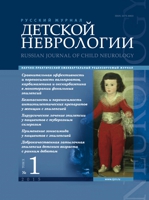Vol 10, No 1 (2015)
- Year: 2015
- Published: 15.01.2015
- Articles: 8
- URL: https://rjdn.abvpress.ru/jour/issue/view/5
Full Issue
AUTHENTIC ARTICLES
COMPARATIVE EFFICАCY AND TOLERABILITY OF MONOTHERAPY WITH DEPAKINE CHRONOSPHERE, DRUGS OF CARBAMAZEPINE GROUP WITH EXTENDED RELEASE AND OXCARBAZEPINE IN SYMPTOMATIC AND CRYPTOGENIC FOCAL EPILEPSY (SVT. LUKA’S INSTITUTE OF CHILD NEUROLOGY AND EPILEPSY)
Abstract
 4-15
4-15


SAFETY AND TOLERABILITY OF ANTIEPILEPTIC DRUGS AT WOMEN WITH EPILEPSY (DATA OF SVT. LUKA’S INSTITUTE OF CHILD NEUROLOGY AND EPILEPSY)
Abstract
 16-23
16-23


REVIEWS AND LECTURES
PECULIARITIES OF TREATMENT OF EPILEPSY AT GIRLS AND WOMEN
Abstract
 24-39
24-39


REVIEW OF FOREIGN LITERATURE
EPILEPSY SURGERY IN PATIENTS WITH TUBEROUS SCLEROSIS
Abstract
With a few exceptions patients with tuberous sclerosis (TS) suffering from drug-resistant epilepsies have potentially epileptogenic lesions
within both hemispheres. Until one decade ago in general such a constellation was an xclusion criteria for considerations with respect to epilepsy surgery. However experience has shown that it is not so rare to find patients in whom over the ears seizures are generated from just one single focus and that these patients can be good candidates for epilepsy surgery. Almost revolutionary was the further evelopment: multi-step procedures in patients with bilateral epileptogenic lesions – with promising results in terms of postoperative seizure outcome. Also, with increasing experience, it becomes more and more possible to differentiate already non-invasively which lesions could be epileptogenic and which are rather not the source of the seizures. The most important achievement of epilepsy surgery in TS however is that in selected cases early surgical intervention is able to prevent severe mental retardations, which are often the main burden for families who have members with this peculiar disease.
 40-46
40-46


CLINICAL OBSERVATIONS
ZONISAMIDE (ZONEGRAN) IN THE TREATMENT OF EPILEPSY IN ADULTS AND CHILDREN (A REVIEW AND CLINICAL CASE)
Abstract
Despite the significant progress made in epileptology, resistant epilepsies constitute approximately 30 % of all forms of epilepsy. An overview of recent literature is provided on the efficacy and safety of a new antiepileptic drug zonisamide (Zonegran) in the treatment of epilepsy with emphasis on monotherapy. The mode of action, pharmacokinetic characteristics, the effectiveness and tolerance of zonisamide in resistant focal epilepsy, as well as other types of seizures and forms of epilepsy are described. Indications for use of the drug are discussed. Also a wider potential for application of zonisamide are described: in the treatment of generalized seizures, in monotherapy as well as in children and adolescents. At present, Zonegran is registered for application in children from 6 years and older, with focal seizures, in additional therapy. The authors present their own observation of high efficacy of zonisamide in adjunctive therapy in a child of 9 years with cryptogenic focal epilepsy. Onset of epileptic seizures at the age of 5 months. Since the onset of the disease the child has received a lot of antiepileptic drugs in various combinations, with no significant effect. Zonisamide (Zonegran) was introduced in therapy 4 months ago in combination with the valproate acid drug (which the child received over the years), and since the release to the full dose epileptic seizures are absent up to present. It should be noted that there was not a single remission of four-month duration since the onset of the disease. Moreover, normalization of sleep has been noted. Tolerability of the therapy is good. No side effects were noted.
 47-63
47-63


ACUTE ATAXIA, TAKING PLACE AFTER ACUTE RESPIRATORY VIRAL INFECTION IN 2 Y. O. GIRL, AS A DEBUT NEUROLOGIC SIGN OF THE ANGELMAN SYNDROME
Abstract
 64-70
64-70


EARLY ONSET BENIGN CHILDHOOD OCCIPITAL EPILEPSY (PANAYIOTOPOULOS SYNDROME). A CASE REPORT
Abstract
The childhood epilepsy with occipital paroxysms and early onset or Panayiotopoulos syndrome is a benign focal epileptic syndrome,
a benign disease, developing at infants. The disease has been described in 1989 by S. Panayiotopoulos on the basis of results of own observations, who has called this syndrome “benign night childhood occipital lobe epilepsy”. In 1996 N. Fejerman et al. offered the new name of the syndrome – benign childhood occipital lobe epilepsy, with earlier onset (Panayiotopoulos type), versus the childhood occipital lobe epilepsy, starting later in childhood (Gastaut type). The Panayiotopoulos syndrome occurs only at children, develops at healthy children without neurological disorders, the pick of disease falls on 4–5 years. The morbidity of boys and girls is almost the same. In most cases of the syndrome seizures take place during the sleep, 2 / 3 of patients report seizures only during sleep. As a rule, seizures last for more than 5 min, in 40 % of cases it last for more than 30 min, what corresponds (according to the consciousness level) to focal or generalized epileptic status criteria. To typical clinical syndromes at Panayiotopoulos syndrome are referred the ictal vomiting, as well as different vegetative symptoms. So, theictal vomiting, which, generally, is not typical for epilepsy, takes place in about 80 % of cases at Panaytopululos syndrome. Authors describe their own observation of the Panayiotopoulos syndrome at 5 years old girl.
 71-77
71-77


ADVANCED TRAINING
 78
78











